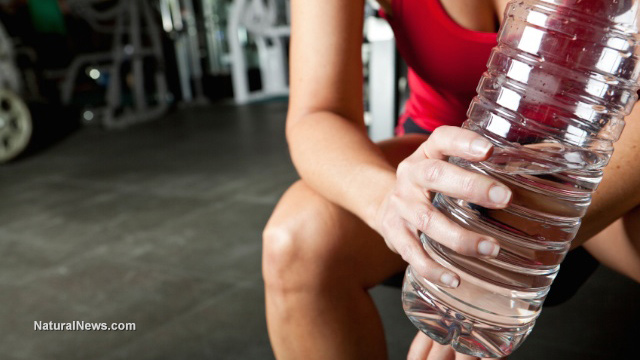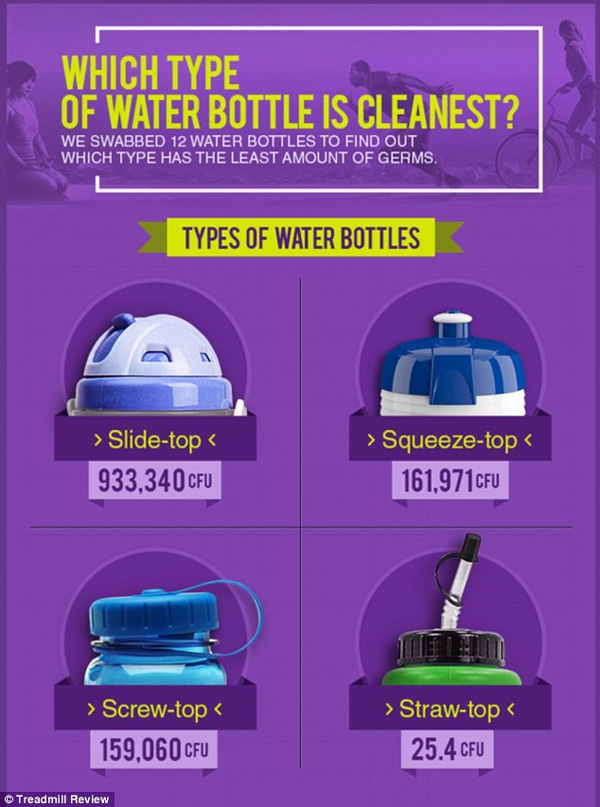Reusable water bottles harbor more germs than your toilet, testing finds
Tuesday, August 16, 2016 by: Julie Wilson staff writer
Tags: plastic water bottles, bacteria, chemicals

(NaturalNews) Recycling your plastic water bottle may seem like a green thing to do, but the truth is it's better to simply avoid plastic altogether, and for a number of reasons. Drinking from a reusable water bottle places you at risk for contracting an array of dangerous germs like E.coli and salmonella.
Laboratory testing of 12 refillable water bottles used by athletes over the course of a week, identified a buildup of bacteria dangerous to humans. On average, the plastic bottles contained more than 300,000 colony-forming units of bacteria, according to the UK's Daily Mail.
The testing, completed by TreadmillReviews.net, found a wide array of bacteria linked to skin infections, pneumonia and blood poisoning. The bottles were so dirty that researchers concluded that drinking from them was no more sanitary than licking your pet's food bowl.
The amount of bacteria found on the reusable water bottles is comparable to the germs you would find on a toilet seat, they added. It turns out that not all plastic bottles are the same in terms of filth, either.
Reusing your water bottle is like eating out of your pet's dirty food bowl
The researchers tested water bottles with a variety of lid types, including slide-top, squeeze-top, screw-top and straw-top. Water bottles with a slide-top harbored the most germs by far, measuring at 933,340 colony-forming units per square centimeter (CFU).The slide-top bottle contained 33 percent gram negative rods, harmful bacteria that are often resistant to antibiotics, and 17 percent gram positive cocci, which may cause strep and staph infections.
The second dirtiest lid is the squeeze-top, with bacteria levels measuring 161,971 CFU. Less than one percent of the bacteria found on this lid type include gram positive cocci.
The screw-top lid, one of the most common types, came in at third dirtiest, containing 159,060 CFU. Ninety-eight percent of bacteria on this lid type consisted of harmful, antibiotic resistant bacteria.

Your water bottle's lid has impact on the amount of bacteria harbored
Finally, the straw-top, probably one of the least used water bottle types, contained fewer germs than the others with an estimated 25 CFU.The straw-top is believed to have the least amount of germs because water drips to the bottom of the straw instead of sticking around at the top attracting bacteria that thrive on moisture.
"Based on our test results, we suggest opting for a straw-top bottle, both for the low prevalence of bacteria and the lack of harmful germs," said the fitness website, adding that stainless steel water bottles are the cleanest and therefore safest choice for users.
Stainless steel water bottles or even glass bottles are optimal for a number of reasons. Not only do they harbor fewer germs, but they don't leach toxic chemicals into your drink.
Plastic water bottles, especially when exposed to heat or sunlight, are known to leach endocrine mimicking chemicals such as BPA (bisphenol-A) and phthalates.
The dangers of chemicals leached from plastic
Endocrine mimickers or hormone disruptors interfere with the body's natural sex hormones, leading to all sorts of health problems including infertility, early puberty, cancer, thyroid problems and more. Even low dose exposure to these chemicals can significantly affect your health."BPA has been linked to everything from breast and others cancers to reproductive problems, obesity, early puberty and heart disease, and according to government tests, 93 percent of Americans have BPA in their bodies!" says the Environmental Working Group.
New research shows that BPA alternatives such as BPS aren't any safer either; in fact, in some cases they are considered more dangerous to humans. All bisphenols are capable of mimicking the body's sex hormones, says Robin Mesnage, research associate with King's College London.
Three bisphenols including BPAF, BPB and BPZ are "more estrogenic than BPA."
(Photo credit: Treadmill Review)
Sources:
DailyMail.co.uk
EWG.org
NRDC.org
Plastic water bottles at FETCH.news
Get independent news alerts on natural cures, food lab tests, cannabis medicine, science, robotics, drones, privacy and more.
Take Action: Support Natural News by linking to this article from your website
Permalink to this article:
Embed article link: (copy HTML code below):
Reprinting this article:
Non-commercial use OK, cite NaturalNews.com with clickable link.
Follow Natural News on Facebook, Twitter, Google Plus, and Pinterest
- Beat cancer with 35% hydrogen peroxide
- GMO genetic pollution alert: Genetically engineered wheat escapes experimental fields planted across 16 states
- Supplements to detox the body from vaccinations
- Frankincense oil kills cancer cells while boosting the immune system, studies show
- Woman shrinks thyroid nodules with pure nutrition, not meds
- Four easy ways to improve your thyroid function
- Heal and Soothe Stomach Ulcers without Mainstream Drugs
- The widely unknown danger of the flu epidemic
- Study: Toxic chemicals in makeup, plastics and other everyday products are harming unborn babies, damaging the brain and reducing IQs
- 4 enzyme rich foods that can dramatically improve digestion
- Reverse and eliminate cataracts naturally without surgery
- Castor oil helps hair breakage, helps to grow and darken hair
- NaturalNews issues consumer alert about Adya Clarity, imported as battery acid and sold for internal consumption
- Discover a common yard weed that's proven to kill cancer cells
- Bill Gates says vaccines can help reduce world population
- Indian black salve: The magical cancer cure
- Boost Low White Blood Cell Count and Immune Function Naturally
- The art of mindful eating - Transform your life in a positive way through better eating habits
- Supplements to detox the body from vaccinations
- Top 10 inexpensive food items that can PREVENT nearly every disease and disorder known to mankind
- Beat cancer with 35% hydrogen peroxide
- The best cure for insomnia
- GMO genetic pollution alert: Genetically engineered wheat escapes experimental fields planted across 16 states
- Reverse and eliminate cataracts naturally without surgery
- 12 easy ways to remove acid build-up from your body, alkalize your pH and beat disease
- Vitamin B-12 warning: Avoid cyanocobalamin, take only methylcobalamin
- Apricot Seeds Kill Cancer Cells without Side Effects
- Big Pharma propaganda now pushing drug that 'treats' racism - chemical mind control?
- The United Nations 2030 Agenda decoded: It's a blueprint for the global enslavement of humanity under the boot of corporate masters
- Coca-Cola to Phase Out Toxic Sodium Benzoate in the U.K.
- Baking soda, cancer and fungus
- Indian black salve: The magical cancer cure
- Bill Gates says vaccines can help reduce world population
- The 21 curious questions we're never allowed to ask about vaccines
- Blood donations from people vaccinated against HPV may be harmful to recipients
- Boost Low White Blood Cell Count and Immune Function Naturally
- The REAL FAKE NEWS exposed: '97% of scientists agree on climate change' is an engineered hoax... here's what the media never told you
- Supplements to detox the body from vaccinations
- The 10 worst toxins hidden in vitamins, supplements and health foods
- Beat cancer with 35% hydrogen peroxide
- Bill Gates says vaccines can help reduce world population
- Four supplements that will benefit almost everyone
- Before his death, father of ADHD admitted it was a fictitious disease
- Cannabis kicks Lyme disease to the curb
- Curcumin slays cancer cells in their tracks
- Boost Low White Blood Cell Count and Immune Function Naturally
- The United Nations 2030 Agenda decoded: It's a blueprint for the global enslavement of humanity under the boot of corporate masters
- Vaccines lower immunity
- Canadian agency attacks Jenny McCarthy for demanding mercury-free vaccines
- The aloe vera miracle: A natural medicine for cancer, cholesterol, diabetes, inflammation, IBS, and other health conditions
- Zeolite detox myths busted: In lab tests, zeolites do NOT bind with aluminum, lead, uranium, mercury or cadmium... only CESIUM
- Forget Filling Cavities: Regrow Your Teeth Instead
- Apricot Seeds Kill Cancer Cells without Side Effects
- The best and worst forms of magnesium to take as a supplement
- EPA advisor admits the agency is funneling billions to climate groups ahead of Trump’s return to White House
- Newly released JFK files reveal Pentagon's role in creating Lyme disease and covid in the same lab
- Eleven days before Iran bombed Tel Aviv, my microscope revealed haunting images of EXACTLY what would happen
- Morphic resonance “remote viewing” reveals iconic Middle East images of stealth bombers, a falcon and a one-horned ram
- Mike Adams releases country western hit single: Goin’ Back in Time is Comin’ Home
- DECENTRALIZED SPIRITUALITY and the true teachings of Christ: Overcoming the censorship, threats and lies of organized religion to truly know God and the Universal Christ
- Global leaders unite to clamp down on “misinformation” with UN-backed Cascais Declaration
- I Want My Bailout Money – new song released by Mike Adams
- HEALTH SECRETS: How to Instantly Block MSG Toxicity Using Natural Substances (and the secret of Methylene Blue)
- The Health Ranger releases “Vaccine Zombie” song and music video, using AI-animated zombies for the music video
- BOMBSHELL: Internal Pfizer documents exposed and reveal at least 16 PERCENT of their mRNA vaccine "adverse events" are REPRODUCTIVE DISORDERS
- BOMBSHELL: Covid-19 mRNA nanoparticles EMIT LIGHT SIGNALS that communicate MAC addresses used for self-assembly inside the blood vessels
- BOMBSHELL: DNA testing kits are a SCAM to develop ethnic-specific bioweapons
- Two containers with completed ballots fall out of truck in Florida
- Amazing microscopy photos reveal how freezing crystals attempt to mimic electronic structures they are touching
- RFK Jr. clears key hurdle: Sen. Susan Collins backs controversial HHS nominee, signaling a new era for health policy
- The Coming Gold Revaluation: Strategic Financial Realignment in an Era of Dollar Collapse
- The AI Data Center Wars Have Begun… Farms, Water and Electricity is Stripped from Humans to Power the Machines
Science News & Studies
Medicine News and Information
Food News & Studies
Health News & Studies
Herbs News & Information
Pollution News & Studies
Cancer News & Studies
Climate News & Studies
Survival News & Information
Gear News & Information
News covering technology, stocks, hackers, and more



"Big Tech and mainstream media are constantly trying to silence the independent voices that dare to bring you the truth about toxic food ingredients, dangerous medications and the failed, fraudulent science of the profit-driven medical establishment.
Email is one of the best ways to make sure you stay informed, without the censorship of the tech giants (Google, Apple, Facebook, Twitter, YouTube, etc.). Stay informed and you'll even likely learn information that may help save your own life."
–The Health Ranger, Mike Adams























